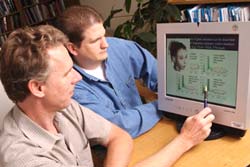UT Southwestern researchers define regions of human genes highly prone to mutation

Dr. Harold "Skip" Garner, foreground, and John W. "Trey" Fondon III have taken the first step in defining the sites in human genes most prone to mutation.
UT Southwestern Medical Center at Dallas researchers have taken the first step in defining the sites in human genes most prone to mutation, which eventually could lead to discovery of the genetic bases of many human diseases.
Their work will appear in an upcoming issue of the journal Gene and is currently available online.
Dr. Harold “Skip” Garner, professor of biochemistry and internal medicine, and his colleagues made their discovery while mining databases of coding single nucleotide polymorphisms (cSNPs) held by the National Center for Biotechnology Information, the SNP Consortium, the National Cancer Institute and the Institute of Medical Genetics at Cardiff, Wales. Single nucleotide polymorphisms (SNPs) are the most common and simplest form of genetic mutation in the human genome.
In their analysis, the researchers showed that a large fraction of human cSNPs occur at only a few distinctive and usually recurrent DNA sequence patterns. However, such events within the genome account for a disproportionate amount of all gene point mutations.
Developing an association between phenotype (the outward, physical manifestation) and genotype (the internally coded, inheritable information) is vital toward understanding and identifying indications of disease.
“This discovery can be used to essentially define the likelihood of one gene to mutate relative to others as a function of both time and environment,” said Monica M. Horvath, molecular biophysics graduate student and co-author. “cSNP trends are critical to quantify in order to develop hypotheses regarding the complexity and range of mutational mechanisms that generate both genome diversity and disease.”
The next phase, Ms. Horvath said, is to employ both experimental and computational tests to benchmark how well these trends can predict mutations not yet found in the human genome.
“What I like the most about this work is that it shows that as proteins evolve, natural selection has considerable latitude, not only in determining the amino acid sequence of a protein, but also in determining how frequently and severely to break it,” said John W. Fondon III, molecular biophysics graduate student and contributing author.
“What Ms. Horvath has done is to essentially crack the code within the code – to reveal how selection exploits redundancy within the genetic code to specify whether a particular amino acid letter in a protein is written in stone, with ink, or in wet sand at low tide.”
An important application of this research is that with enhanced knowledge of where mutations are most likely to occur, medical geneticists can take more aggressive approaches to discover the genetic basis of many human diseases.
“We know the genome is very big, and there currently is no technology to remeasure every single letter of this 3-billion-letter code,” said Dr. Garner.
“A very significant byproduct of this research into the complex interplay between mutation and selection is that Ms. Horvath has revealed some clear rules that can contribute to the design and execution of genetic association studies. This will become an important component of the solution to the currently intractable problems presented by complex diseases that involve many genes.”
The research was supported by a National Institute of Health grant, Program in Genomic Applications grant, the Biological Chemical Countermeasures program of The University of Texas and the state of Texas Advanced Technology Program.
Media Contact: Scott Maier
214-648-3404
or e-mail: scott.maier@utsouthwestern.edu
Media Contact
More Information:
http://irweb.swmed.edu/newspub/newsdetl.asp?story_id=628All latest news from the category: Life Sciences and Chemistry
Articles and reports from the Life Sciences and chemistry area deal with applied and basic research into modern biology, chemistry and human medicine.
Valuable information can be found on a range of life sciences fields including bacteriology, biochemistry, bionics, bioinformatics, biophysics, biotechnology, genetics, geobotany, human biology, marine biology, microbiology, molecular biology, cellular biology, zoology, bioinorganic chemistry, microchemistry and environmental chemistry.
Newest articles

Nerve cells of blind mice retain their visual function
Nerve cells in the retina were analysed at TU Wien (Vienna) using microelectrodes. They show astonishingly stable behavior – good news for retina implants. The retina is often referred to…

State-wide center for quantum science
Karlsruhe Institute of Technology joins IQST as a new partner. The mission of IQST is to further our understanding of nature and develop innovative technologies based on quantum science by…

Newly designed nanomaterial shows promise as antimicrobial agent
Rice scientists develop nanocrystals that kill bacteria under visible light. Newly developed halide perovskite nanocrystals (HPNCs) show potential as antimicrobial agents that are stable, effective and easy to produce. After…



